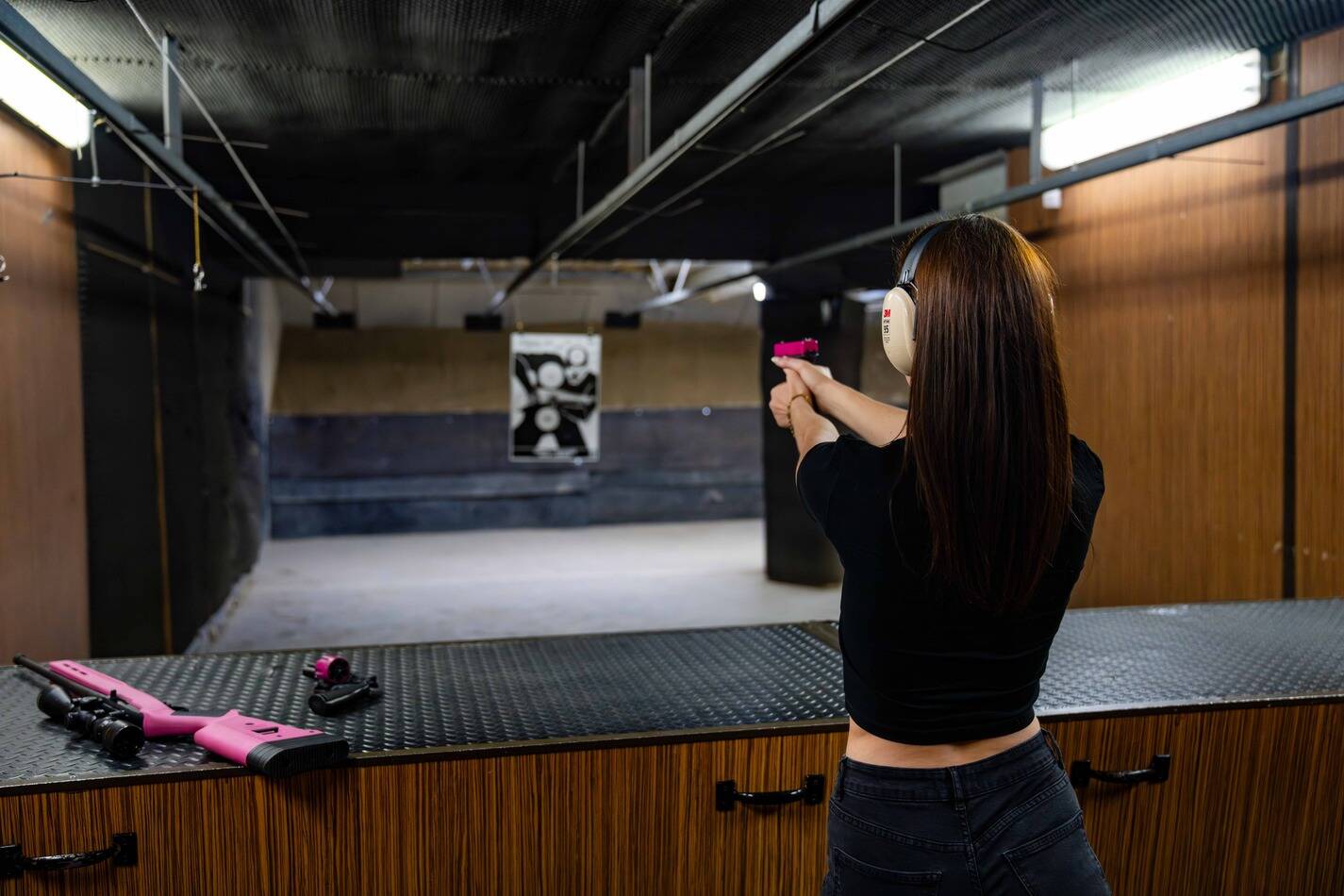Marksmanship is a precise skill that requires focus, practice, and routine steps for safe and accurate shots. Learning to handle and use a firearm safely and efficiently is achieved by mastering the 6 basic fundamentals of shooting, allowing you to become a more confident and precise shooter. The expert rangers at our Cape Town indoor shooting range, Gun Fun, will take you through the fundamentals of shooting and provide hands-on guidance for your shooting experience.
1. Stance
The stance is the foundation of every shot. Maintaining a good stance refers to your keeping your body and feet position relative to the target. Different stances are suitable for different situations, firearm types, and target sizes. A few of the most popular stances are:
- Bullseye: One-handed stance with feet shoulder-width apart at a 45-degree angle to the target. Non-firing hand anchors in your pocket for stability.
- Weaver: Two-handed stance for action shooting, with feet angled, strong arm straight, and weak arm bent. Provides upper body lock and recoil control.
- Isosceles: Body directly facing the target, both hands on the gun, arms straight out, and upper body slightly leaned forward.
2. Grip
When it comes to holding and aiming your firearm, grip is up there with the most important things to learn and remember. The goal is to grip your gun with enough strength to prevent it from moving during the shot, but relaxed enough so that your hand doesn’t shake from the pressure. Here’s how to achieve a good grip:
- Form a “V” with your dominant hand, placing the thumb on one side and fingers on the other.
- Center the gun in the V, wrapping your middle, ring, and pinky fingers around the grip.
- Place your index finger pad between the joint and tip on the trigger, avoiding excessive insertion.
3. Sight Alignment
This involves aligning the rear and front sights of your gun for a precise shot. Focus on the front sight post while ensuring the rear sight aperture frames it correctly. The target will appear blurry if done correctly.
While not included in this list, “sight picture” also plays a crucial role in certain firearm types. Sight picture refers to the image seen when your sight ‘aligns’ with the target, helping you centre the object for more accurate aiming.
4. Breathing
Maintain calm and regular breathing pattern throughout preparation, aim, and firing. In fact, breathing control is very important and often not practiced enough. The ideal moment to pull the trigger is when your breathing cycle reaches a natural pause (normally at the end of an exhale). Your breaths should be consistent with your aiming and sight alignment, meaning you should try fire shots in a pattern that matches your breathing rhythm.
- Breathing steadily oxygenates your blood and Improves focus and alertness.
- Breathing control can help relax your nerves and optimises muscle control for more stable shots.
- Maintaining a natural and consistent breathing pattern helps prevent jerky movements and ensures smoother aiming and trigger control.
You might think that holding your breath can create more stability, but it’s not a good idea to hold your breath in or force your breath out. Focusing on your breathing too much can create unnecessary tension in your chest muscles or make your body feel like it needs to gasp for air—which can cause you to shake.
5. Trigger Squeeze
Press the trigger smoothly without disturbing your sight alignment. The ideal trigger control position, using the top finger pad, allows for independent movement of the index finger while maintaining contact with the trigger. This part of the finger is the most sensitive, and allows for more accurate control and discharge of your firearm. It doesn’t matter how fast or slow you position your finger, control of the trigger depends on the size and distance of your target.
Remember to avoid ‘pulling’ and ‘pushing’. Placing too much finger on the trigger can causing a hooked effect that ‘pulls’ the gun off-target. Conversely, using too little finger results in a side ‘push’ that often throws the shot off-target too.
6. Follow Through
After you’ve pulled the trigger, your work isn’t done. Just like a golf swing or a tennis serve, the follow-through in shooting is just as crucial for accuracy and control. Imagine this: You fire the gun, the recoil knocks your sights off target, and you instinctively flinch by releasing the trigger too early. This disrupts your aim and ruins your chance for a follow-up shot.
It is important to keep your trigger finger fully depressed even after the shot. Follow-through is especially vital in situations requiring multiple shots or rapid fire. It allows you to maintain control, avoid flinching, and transition seamlessly between shots with improved accuracy.
For some firearms, like revolvers, the trigger needs to be released manually for each shot. But this doesn’t change the importance of maintaining proper follow-through until your sights re-align.






